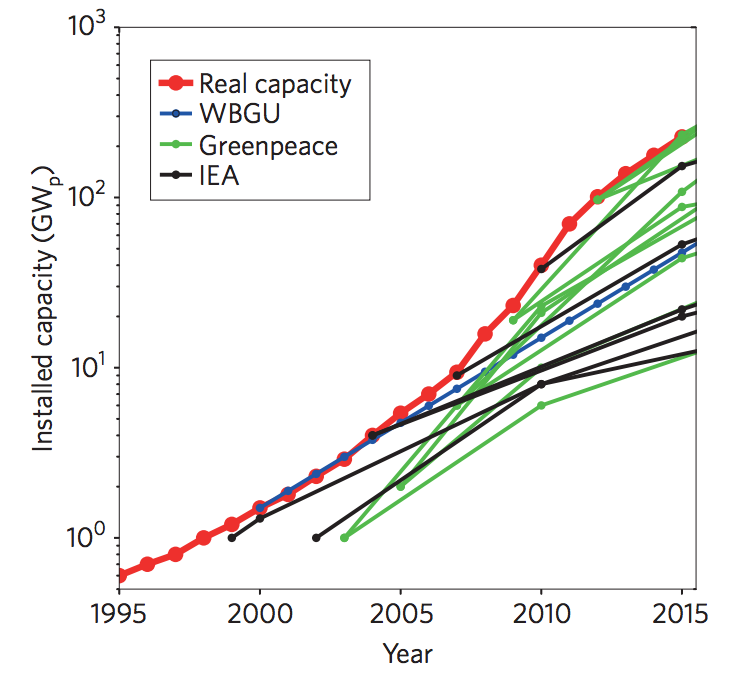
Guest Post: Why solar keeps being underestimated

Dr Felix Creutzig
08.25.17Dr Felix Creutzig is chair of sustainability economics of human settlements at the Technical University Berlin and is head of a working group on land use, infrastructure and transport at the Mercator Research Institute on Global Commons and Climate Change, Berlin.
There are competing ideas on the best technologies to rapidly decarbonise the energy system, as required to avoid dangerous climate change.
Some scenarios emphasise the role of carbon capture and storage to render coal- and gas-fired power plants more climate-friendly. Others point to nuclear energy and a third group is more optimistic on renewable sources.
But it’s plausible that even these more optimistic outlooks have greatly underestimated the potential of solar power. In an analysis, just published in Nature Energy, my colleagues and I ask why this has happened and how much solar could contribute to climate mitigation.
Solar scenarios
There is huge variability in renewables’ expected contribution to the future energy mix. A scenario comparison study that fed into the Intergovernmental Panel on Climate Change (IPCC) found global solar electricity generation ranging from 8–35 exajoules (EJ) per year in 2050, in scenarios consistent with keeping temperatures below 2C.
This corresponds to around 5–17% of global electricity supply. In contrast, the same study projects biomass-based energy supplying 50–90EJ per year in 2050.
Energy futures are typically analysed in scenarios from the International Energy Agency (IEA) and energy system models deployed to inform the IPCC. Importantly, IEA scenarios are often used to calibrate the IPCC scenarios. The resulting projections indicate a large role for coal, coupled with capturing and storing CO2 underground, nuclear and biomass.
But historically, these studies seem biased against solar. In our Nature Energy analysis, my colleagues and I show that projections by both the IEA (black lines in the chart, below) and Greenpeace (green lines) – which is certainly not guilty of an aversion to solar – consistently underestimated the real rate of deployment (red line).

Real growth of solar PV capacity (gigawatts, red line) has consistently outperformed projections from the IEA (black lines), the German Advisory Council on Global Change (WGBU, blue line) and even Greenpeace (green lines). Source: Creutzig 2017.
The IEA, a key reference for all modellers, predicted growth rates of 16-32% per year between 1998 and 2010. In fact, real growth ranged from 20-72%, with the annual average at 38%. This difference caused huge under-predictions of how much solar would be installed.
While an average growth rate of 19% leads to 470% growth over 10 years, a growth rate of 38% can produce a 2,500% increase in capacity in a decade. Even the most optimistic scenarios, published by Greenpeace from 2007–2010, underestimated solar growth. Initially high growth rates were expected to fall to 24-32% per year, a rate that has been surpassed by real-world development.
Models and scenarios have underestimated the growth of solar capacity not once, but repeatedly, so that the gap between prediction and reality fails to narrow down.
Missing models
Why is there such a gap between expectation and reality? Admittedly, solar’s growth, starting from a miniscule base, has been spectacular. Few technologies have taken hold so fast.
Consumers proved willing to pay a premium for green technology on their own rooftops, while ambitious policy instruments like Germany’s Feed-in-Tariff and California’s Renewable Portfolio Standard pushed renewables much faster than anticipated.
These dynamics have so far been poorly captured by energy system models, which tended to represent the complex mix of different climate policies in a simplified and stylised way – for example, as a single, economy-wide carbon price. These models also assume that society will always seek to minimise costs, ignoring the potential role of personal preferences.
Most importantly, faster initial deployment caused costs to decline rapidly and consistently. In fact, solar module costs decreased by around 23% with each doubling in installed capacity, a phenomenon dubbed “technological learning“. Traditionally, technological learning has been inadequately reflected in many models.
The levelised costs of solar are now undercutting fossil fuels in competitive markets. In locations as diverse as Dubai, Mexico, and Chile, the best solar PV projects are selling power at less than $0.03 per kilowatt hour (kWh). In India or Zambia, some PV projects are producing power at or below $0.06/kWh, outcompeting coal.
One final factor explaining why models have underestimated solar is their cost projections for other technologies. As a result, they have not only overestimated the costs of solar, they have also been too optimistic about cost reductions for the alternatives or even failed to foresee cost increases.
Realistic potential
In our analysis, we came up with new estimates of solar’s realistic potential using a global model of the energy system, economy and climate, called REMIND, from the Potsdam Institute for Climate Impact Research.
We plugged into this model the observed development of solar capacity and its costs, along with a revised approach to estimating technological learning rates. A crucial parameter in this is the floor cost, in other words the cost at which technological learning in PV levels off.
Our results were remarkable. By 2050, solar supplies 30% of electricity in competitive markets (without subsidy) worldwide, under pessimistic assumptions on floor costs and up to 50% under more optimistic assumptions.
In other words, our electricity systems will be transformed from relying on consistent “baseload” coal to variable solar. This offers a somewhat bright outlook for climate change mitigation, but would also change the landscape of, and demands on, global electricity markets.
Realising this solar potential will depend on crucial policy planks and support. Coal and other fossil fuels are deeply entrenched and have considerable political power behind them. Moreover, fossil fuels can provide power whenever it is demanded, whereas the sun may not shine at the moment consumers demand electricity.
As solar becomes more central to energy supplies, battery systems and storage become increasingly important. Some states like Vermont already deploy Tesla’s home battery systems to help stabilise the grid. And in Minnesota, a study suggests solar power together with battery storage is a more cost effective way to balance the grid than natural gas.
Battery costs are declining even faster than those of solar power. That is a fortunate coincidence, as storage costs rather than photovoltaic costs will be the determining factor for solar investments. Another new study, also just published in Nature Energy, finds that a combination of solar, wind and battery storage can plausibly directly compete with fossil-fuel based electricity options.
Of course, effective climate mitigation is not assured even if the use of solar and wind power rise. In the absence of solid measures to remove coal, gas and oil from the energy system, fossil fuels could co-exist in an infelicitous equilibrium with renewable energies for decades to come. Pricing out polluting coal through carbon taxation would complement policy designed to boost solar’s share of the global electricity mix.
Creutzig et al. (2017) The underestimated potential of solar energy to mitigate climate change. Nature Energy, doi: 10.1038/nenergy.2017.140

